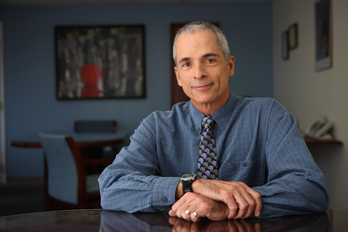
This article was written by John Whyte, MD, PhD (above), founding director, Responsiveness Program, Drucker Brain Injury Center and institute scientist emeritus at Moss Rehabilitation Research Institute (MRRI). The Drucker Brain Injury Center has been part of the federally designated MossRehab Traumatic Brain Injury Model System (TBIMS) since 1997.
For many years, patients with a disorder of consciousness (DOC) after brain injury were typically excluded from acute inpatient rehabilitation facilities and treated in subacute nursing facilities or in family homes with medical support.
The reason is that rehabilitation after brain injury has traditionally required the active participation of the patient to learn new skills and ways of coping with their disability and DOC patients are either unconscious or minimally conscious following the injury.
Professionals working with this population have noted several concerns with this approach to care.
First, where a patient is discharged to is largely determined by their state of consciousness when other medical problems have stabilized enough to allow transfer to another facility. Ironically, patients with fewer other injuries and medical problems may lose the opportunity for rehabilitation because they are medically ready for acute care discharge “too soon,” while still unconscious.
Secondly, studies have shown that as many as 40% of patients who are beginning to regain consciousness are misdiagnosed as vegetative (unconscious) when evaluated by non-specialists, suggesting that patients with unrecognized consciousness may not be referred to rehabilitation.
Finally, in this context of pessimism, care is withdrawn early from many patients whose prognosis is viewed as hopeless, even though this determination cannot be made accurately in the early days after injury.
Fortunately, recent research has begun to change the view of hopelessness in these circumstances. Studies have shown that patients who are unconscious when they do enter acute rehabilitation often show strong improvement and participate actively before discharge. Moreover, they have a high frequency of medical complications, many of which may be unfamiliar to non-specialists. Even patients who are unable to actively participate in rehabilitation at the onset can benefit from:
- Accurately determining their current state of consciousness
- Determining the prognosis for return of consciousness and further functional recovery
- Identifying and treating medical complications that may delay recovery and result in costly acute hospitalizations
- Avoiding deformities and skin breakdown
- Providing education and training for caregivers to allow them to feel confident with whatever level of care they choose to provide.
Clinicians and researchers within the TBIMS in collaboration with colleagues from the American Congress of Rehabilitation Medicine (ACRM), have long sought to expand access to brain injury rehabilitation for DOC patients. They have been important contributors to the evidence that has shown greater long-term recovery and better functional outcomes in this population than previously believed. Thus, the time is right for more forceful evidence-based advocacy for intensive inpatient rehabilitation access.
However, since access to rehabilitation has been restricted for many years, even facilities with substantial TBI and stroke rehabilitation expertise are not necessarily skilled in caring for patients with DOC. If rehabilitation access for this population is to expand, it is important to ensure that the necessary staff, resources, and skills are available in the programs that hope to treat them.
Over the last several years, experts at TBIMS and ACRM have collaborated to develop consensus-based recommendations for the minimum competencies needed by programs serving this population in order to deliver competent care.
The 21 recommendations focus on skills and processes needed for diagnosis and outcome prediction, treatment, transitioning of care, and ethical issues. The recommendations are supported by research evidence where available, and they are accompanied by an “audit checklist” that allows a program to evaluate itself or an external reviewer to assess a program against these criteria. recommendations are available in published form. I’m proud to have served as a lead author.